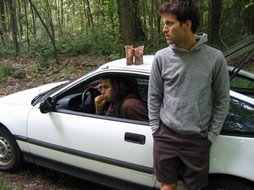"We have made Italy, now we must make Italians." --Massimo D'Azeglio
This weekend I visited a First birthday celebration with my host parents. The big shindig is a holdover from a time when severe diseases commonly hit children right after childbirth and made their first year of life an uncertain one for the parents. Its the "we're going to make it" celebration when, it was expected, the threat of disease had passed. Special rice cakes are made and passed around to everyone in attendance to ward off evil spirits that may hiding around some corner in the baby's future. The baby wears a weird costume and I think rides on someone's back. The biggest part of the celebration though is when the child chooses from a big assortment of different objects one that will represent their future passion or occupation. So included here is a paint brush (artist), noodles (cook), book (scholar), pencil (writer), instrument (musician), money (rich person), and a few other things that I forget at the moment. At this particular party the baby girl choose a paint brush.
More interesting than the ceremony itself, is that its only recently that this ceremony has been practiced across the board by almost everybody in the country. For example, my host father, host mother, and many of the teachers at my old school had never had the ceremony. According to my host father, this is because the ceremony was reserved for the Yangban(upper classes) until the Japanese occupation. I'm guessing that with most people's incomes rising alot in the last twenty years, people have had more disposable income to throw at these big broo-hahas.
Lately though I've been wondering how this, and many things Korean, are a response to the period of Japanese occupation, the formation of an independent state afterwards, and the collapse of the extremely rigid Joseon dynasty class system in the midst of those two events. Cultural practices that were once strictly reserved for certain segments of the population suddenly seem to have been universalized. Instead of people carrying on only the traditions that distinguish their former class, they've been picking and choosing between those traditions that distinguish themselves and the country as Korean. Take the Hanbok --traditional Korean dress -- for example. The common hanbok worn by most people during formal occasions now is modeled after what the upper classes and rich wore during the Joseon dynasty. A majority of people couldn't afford clothes this fancy, and instead wore much plained cotton or hemp based clothes instead of the silk or imitation silk of the upper class designs. Farm music and royal court music has also been elevated to a reputable status and enjoyed by most people regardless of class.
The list goes on with these different cultural symbols, but most of these I think have been promoted by the media, education system, and individual Koreans themselves as defining qualities of Korean culture as they tried to define their country in the wake of the Japanese occupation and the quick modernization that took place after the civil war. An ethnographer writing during the 1980s described talking to Korean students in Seoul during the 1980s and telling them that she was studying Korean culture. The ethnographer said that overwhelmingly, these students asked what there really was of Korean culture to study. They felt, she said, that most of it had been destroyed between the occupation, the war, American influence, and their rapid development. At the same time though this was a period when people were beginning to rediscover traditional cultural practices perhaps out of anxiety over that lost past. In my school last year, everything remotely traditional and idiosyncratic was promoted to me as the legacy of "our nation." It'll be interesting to see what will continue to be practiced and evolve and what will be preserved as little more than nods to the past.
Sunday, November 30, 2008
Subscribe to:
Post Comments (Atom)

1 comment:
"The baby wears a weird costume and I think rides on someone's back."
hahahahahaha
Post a Comment